Midwestern State University NURS 3882: HIV/AIDS Vulnerable Populations
VerifiedAdded on 2022/12/23
|10
|2913
|42
Report
AI Summary
This report examines the impact of HIV/AIDS on vulnerable populations, specifically focusing on the United States. It begins with an introduction to HIV/AIDS, including its global prevalence and the situation in the USA, highlighting the vulnerability of specific populations like African Americans. The report then delves into the primary factors contributing to health disparities, such as sex, age, genetics, and socioeconomic factors. It explores how culture and ethnicity influence the physical and psychological health of HIV-infected individuals. The report also outlines strategies for effective communication with HIV-infected individuals, including overcoming language barriers and addressing cultural sensitivities. Furthermore, it discusses strategies for incorporating cultural information into the nursing process, emphasizing the role of nursing in reducing health disparities. Finally, it reflects on how the student's own cultural background may influence nursing care when working with HIV patients. The report concludes with a summary of the key findings and references relevant sources.
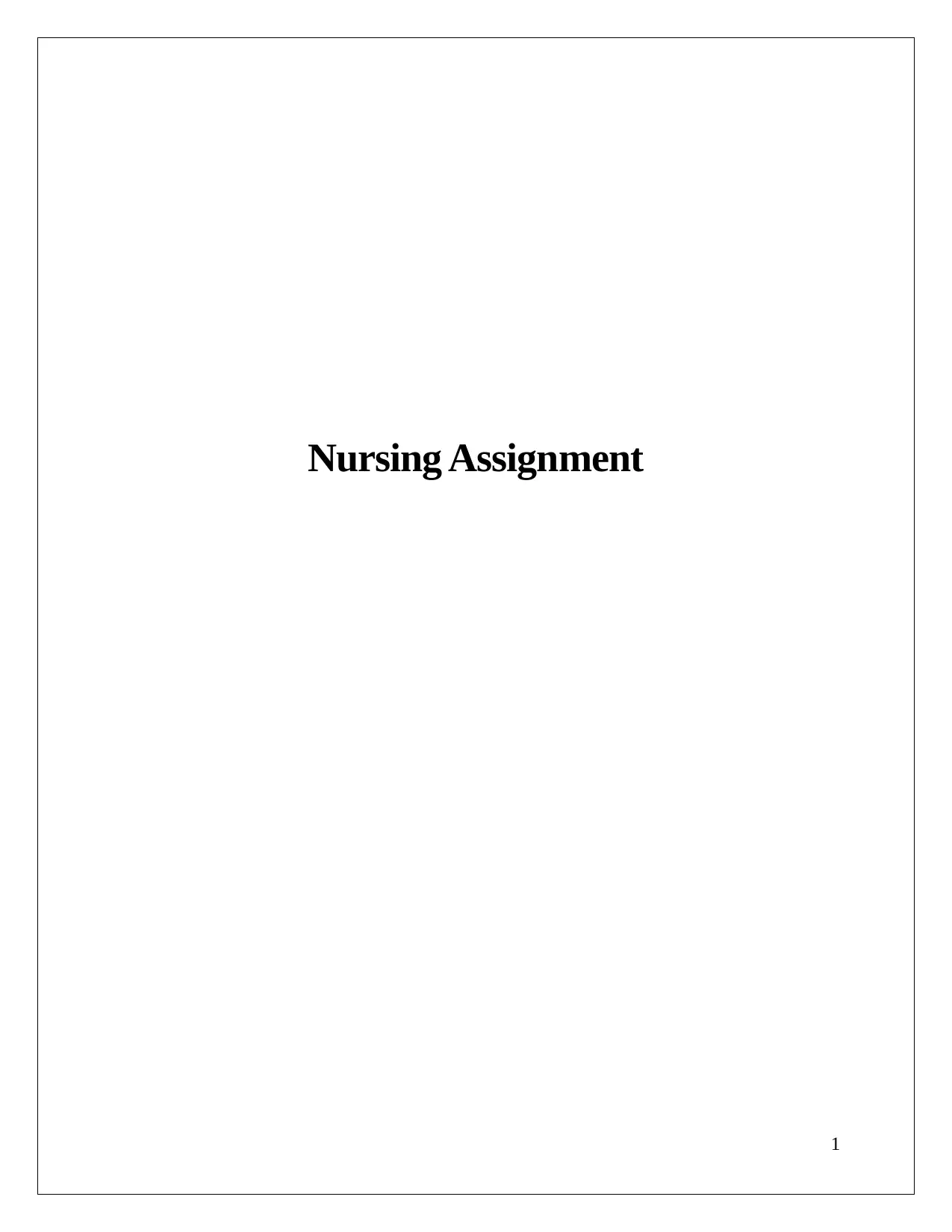
Nursing Assignment
1
1
Paraphrase This Document
Need a fresh take? Get an instant paraphrase of this document with our AI Paraphraser
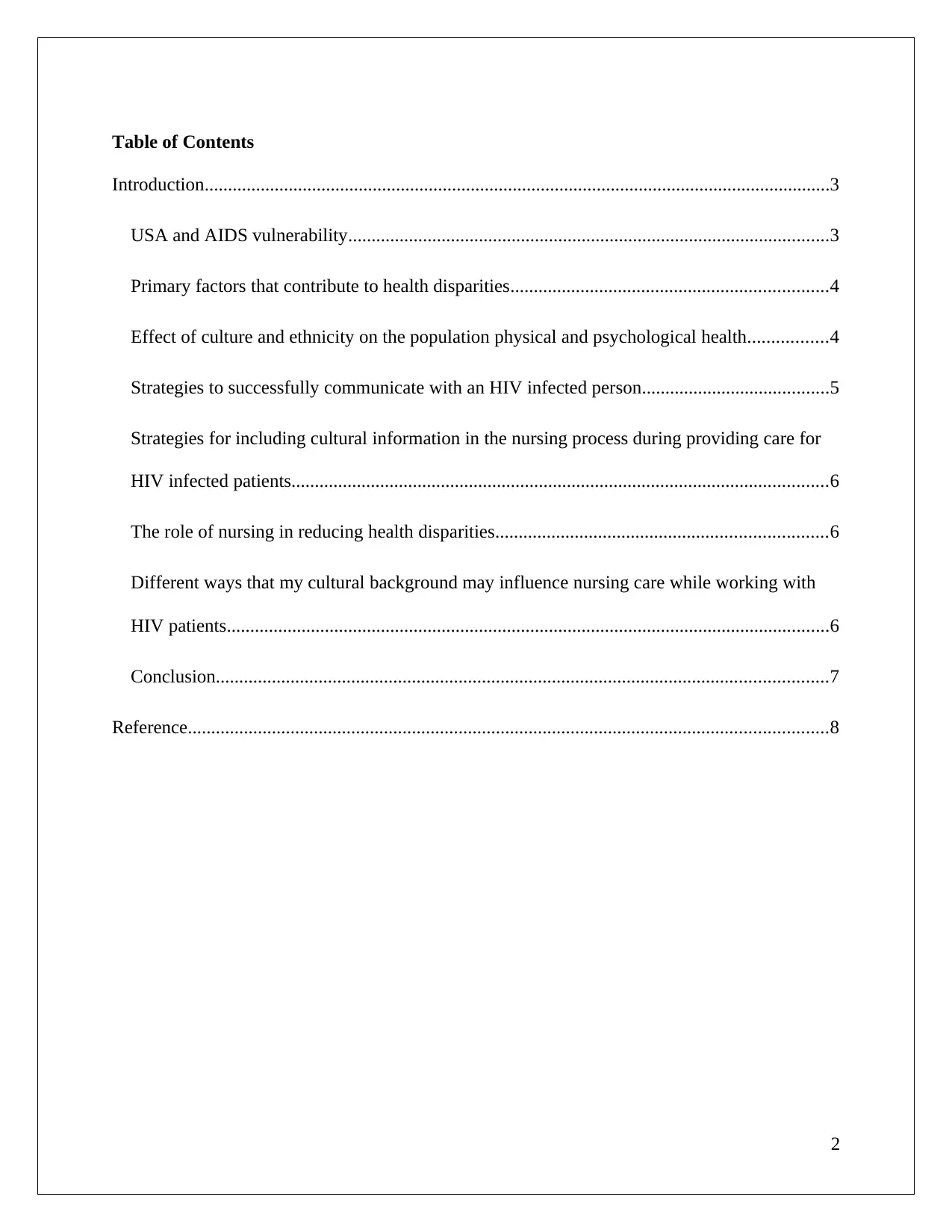
Table of Contents
Introduction......................................................................................................................................3
USA and AIDS vulnerability.......................................................................................................3
Primary factors that contribute to health disparities....................................................................4
Effect of culture and ethnicity on the population physical and psychological health.................4
Strategies to successfully communicate with an HIV infected person........................................5
Strategies for including cultural information in the nursing process during providing care for
HIV infected patients...................................................................................................................6
The role of nursing in reducing health disparities.......................................................................6
Different ways that my cultural background may influence nursing care while working with
HIV patients.................................................................................................................................6
Conclusion...................................................................................................................................7
Reference.........................................................................................................................................8
2
Introduction......................................................................................................................................3
USA and AIDS vulnerability.......................................................................................................3
Primary factors that contribute to health disparities....................................................................4
Effect of culture and ethnicity on the population physical and psychological health.................4
Strategies to successfully communicate with an HIV infected person........................................5
Strategies for including cultural information in the nursing process during providing care for
HIV infected patients...................................................................................................................6
The role of nursing in reducing health disparities.......................................................................6
Different ways that my cultural background may influence nursing care while working with
HIV patients.................................................................................................................................6
Conclusion...................................................................................................................................7
Reference.........................................................................................................................................8
2
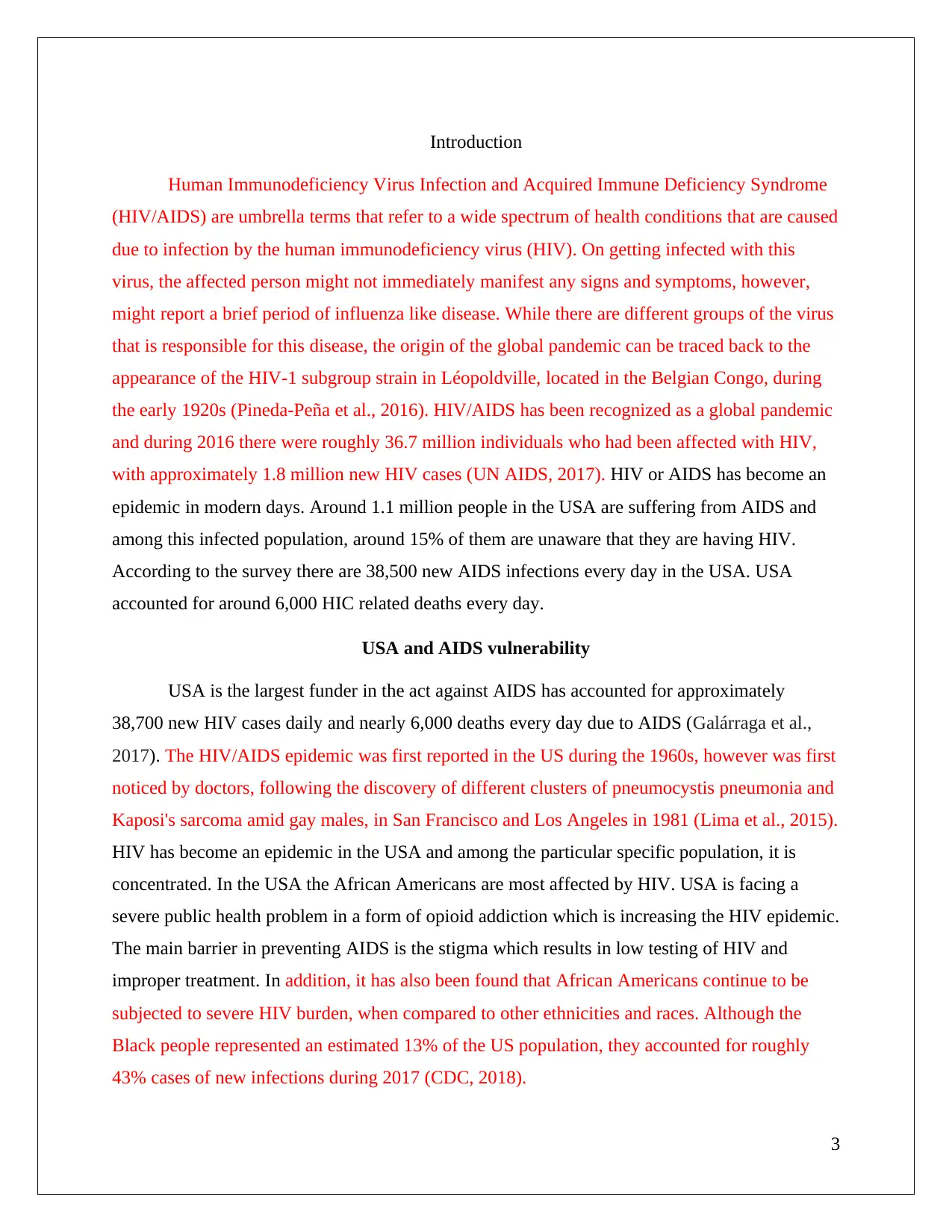
Introduction
Human Immunodeficiency Virus Infection and Acquired Immune Deficiency Syndrome
(HIV/AIDS) are umbrella terms that refer to a wide spectrum of health conditions that are caused
due to infection by the human immunodeficiency virus (HIV). On getting infected with this
virus, the affected person might not immediately manifest any signs and symptoms, however,
might report a brief period of influenza like disease. While there are different groups of the virus
that is responsible for this disease, the origin of the global pandemic can be traced back to the
appearance of the HIV-1 subgroup strain in Léopoldville, located in the Belgian Congo, during
the early 1920s (Pineda-Peña et al., 2016). HIV/AIDS has been recognized as a global pandemic
and during 2016 there were roughly 36.7 million individuals who had been affected with HIV,
with approximately 1.8 million new HIV cases (UN AIDS, 2017). HIV or AIDS has become an
epidemic in modern days. Around 1.1 million people in the USA are suffering from AIDS and
among this infected population, around 15% of them are unaware that they are having HIV.
According to the survey there are 38,500 new AIDS infections every day in the USA. USA
accounted for around 6,000 HIC related deaths every day.
USA and AIDS vulnerability
USA is the largest funder in the act against AIDS has accounted for approximately
38,700 new HIV cases daily and nearly 6,000 deaths every day due to AIDS (Galárraga et al.,
2017). The HIV/AIDS epidemic was first reported in the US during the 1960s, however was first
noticed by doctors, following the discovery of different clusters of pneumocystis pneumonia and
Kaposi's sarcoma amid gay males, in San Francisco and Los Angeles in 1981 (Lima et al., 2015).
HIV has become an epidemic in the USA and among the particular specific population, it is
concentrated. In the USA the African Americans are most affected by HIV. USA is facing a
severe public health problem in a form of opioid addiction which is increasing the HIV epidemic.
The main barrier in preventing AIDS is the stigma which results in low testing of HIV and
improper treatment. In addition, it has also been found that African Americans continue to be
subjected to severe HIV burden, when compared to other ethnicities and races. Although the
Black people represented an estimated 13% of the US population, they accounted for roughly
43% cases of new infections during 2017 (CDC, 2018).
3
Human Immunodeficiency Virus Infection and Acquired Immune Deficiency Syndrome
(HIV/AIDS) are umbrella terms that refer to a wide spectrum of health conditions that are caused
due to infection by the human immunodeficiency virus (HIV). On getting infected with this
virus, the affected person might not immediately manifest any signs and symptoms, however,
might report a brief period of influenza like disease. While there are different groups of the virus
that is responsible for this disease, the origin of the global pandemic can be traced back to the
appearance of the HIV-1 subgroup strain in Léopoldville, located in the Belgian Congo, during
the early 1920s (Pineda-Peña et al., 2016). HIV/AIDS has been recognized as a global pandemic
and during 2016 there were roughly 36.7 million individuals who had been affected with HIV,
with approximately 1.8 million new HIV cases (UN AIDS, 2017). HIV or AIDS has become an
epidemic in modern days. Around 1.1 million people in the USA are suffering from AIDS and
among this infected population, around 15% of them are unaware that they are having HIV.
According to the survey there are 38,500 new AIDS infections every day in the USA. USA
accounted for around 6,000 HIC related deaths every day.
USA and AIDS vulnerability
USA is the largest funder in the act against AIDS has accounted for approximately
38,700 new HIV cases daily and nearly 6,000 deaths every day due to AIDS (Galárraga et al.,
2017). The HIV/AIDS epidemic was first reported in the US during the 1960s, however was first
noticed by doctors, following the discovery of different clusters of pneumocystis pneumonia and
Kaposi's sarcoma amid gay males, in San Francisco and Los Angeles in 1981 (Lima et al., 2015).
HIV has become an epidemic in the USA and among the particular specific population, it is
concentrated. In the USA the African Americans are most affected by HIV. USA is facing a
severe public health problem in a form of opioid addiction which is increasing the HIV epidemic.
The main barrier in preventing AIDS is the stigma which results in low testing of HIV and
improper treatment. In addition, it has also been found that African Americans continue to be
subjected to severe HIV burden, when compared to other ethnicities and races. Although the
Black people represented an estimated 13% of the US population, they accounted for roughly
43% cases of new infections during 2017 (CDC, 2018).
3
⊘ This is a preview!⊘
Do you want full access?
Subscribe today to unlock all pages.

Trusted by 1+ million students worldwide
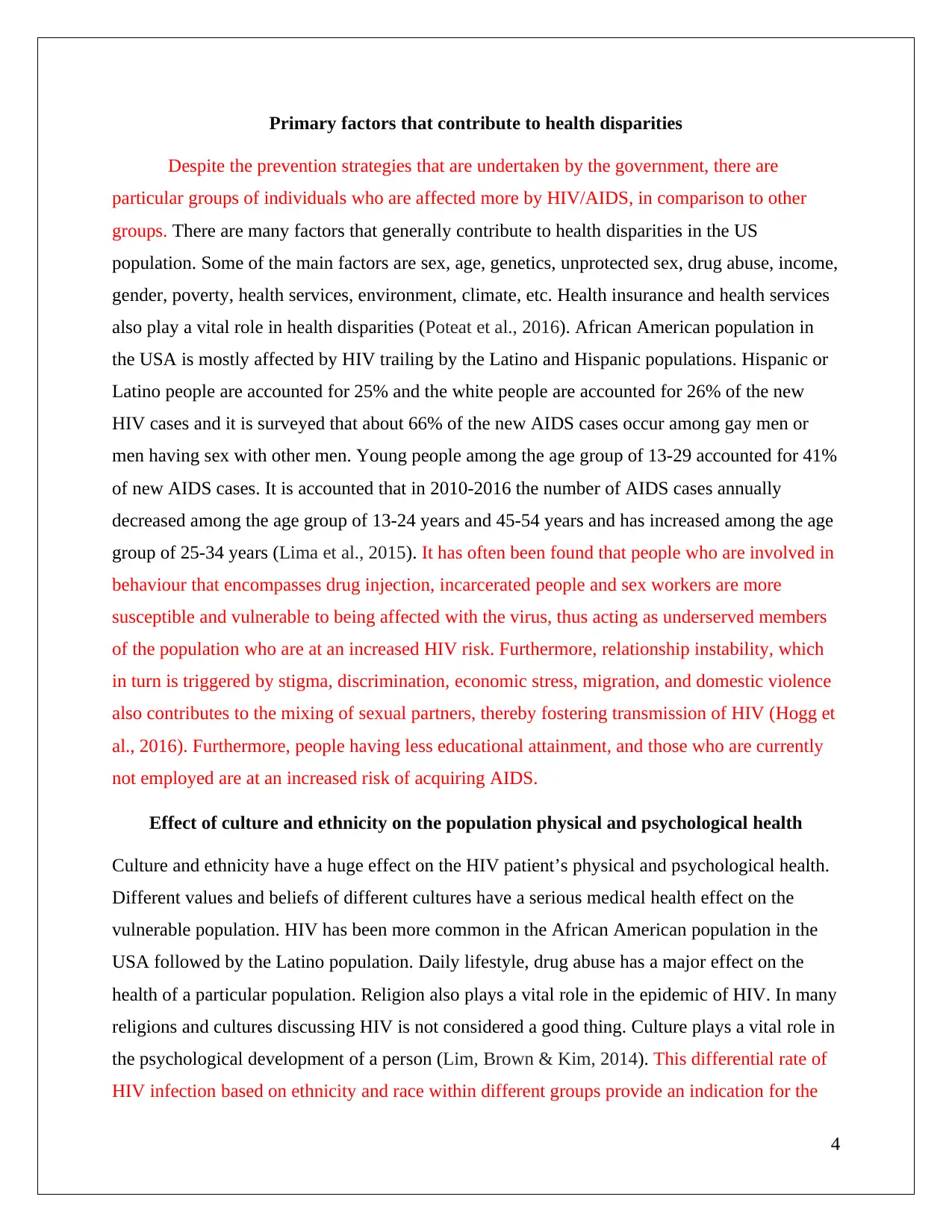
Primary factors that contribute to health disparities
Despite the prevention strategies that are undertaken by the government, there are
particular groups of individuals who are affected more by HIV/AIDS, in comparison to other
groups. There are many factors that generally contribute to health disparities in the US
population. Some of the main factors are sex, age, genetics, unprotected sex, drug abuse, income,
gender, poverty, health services, environment, climate, etc. Health insurance and health services
also play a vital role in health disparities (Poteat et al., 2016). African American population in
the USA is mostly affected by HIV trailing by the Latino and Hispanic populations. Hispanic or
Latino people are accounted for 25% and the white people are accounted for 26% of the new
HIV cases and it is surveyed that about 66% of the new AIDS cases occur among gay men or
men having sex with other men. Young people among the age group of 13-29 accounted for 41%
of new AIDS cases. It is accounted that in 2010-2016 the number of AIDS cases annually
decreased among the age group of 13-24 years and 45-54 years and has increased among the age
group of 25-34 years (Lima et al., 2015). It has often been found that people who are involved in
behaviour that encompasses drug injection, incarcerated people and sex workers are more
susceptible and vulnerable to being affected with the virus, thus acting as underserved members
of the population who are at an increased HIV risk. Furthermore, relationship instability, which
in turn is triggered by stigma, discrimination, economic stress, migration, and domestic violence
also contributes to the mixing of sexual partners, thereby fostering transmission of HIV (Hogg et
al., 2016). Furthermore, people having less educational attainment, and those who are currently
not employed are at an increased risk of acquiring AIDS.
Effect of culture and ethnicity on the population physical and psychological health
Culture and ethnicity have a huge effect on the HIV patient’s physical and psychological health.
Different values and beliefs of different cultures have a serious medical health effect on the
vulnerable population. HIV has been more common in the African American population in the
USA followed by the Latino population. Daily lifestyle, drug abuse has a major effect on the
health of a particular population. Religion also plays a vital role in the epidemic of HIV. In many
religions and cultures discussing HIV is not considered a good thing. Culture plays a vital role in
the psychological development of a person (Lim, Brown & Kim, 2014). This differential rate of
HIV infection based on ethnicity and race within different groups provide an indication for the
4
Despite the prevention strategies that are undertaken by the government, there are
particular groups of individuals who are affected more by HIV/AIDS, in comparison to other
groups. There are many factors that generally contribute to health disparities in the US
population. Some of the main factors are sex, age, genetics, unprotected sex, drug abuse, income,
gender, poverty, health services, environment, climate, etc. Health insurance and health services
also play a vital role in health disparities (Poteat et al., 2016). African American population in
the USA is mostly affected by HIV trailing by the Latino and Hispanic populations. Hispanic or
Latino people are accounted for 25% and the white people are accounted for 26% of the new
HIV cases and it is surveyed that about 66% of the new AIDS cases occur among gay men or
men having sex with other men. Young people among the age group of 13-29 accounted for 41%
of new AIDS cases. It is accounted that in 2010-2016 the number of AIDS cases annually
decreased among the age group of 13-24 years and 45-54 years and has increased among the age
group of 25-34 years (Lima et al., 2015). It has often been found that people who are involved in
behaviour that encompasses drug injection, incarcerated people and sex workers are more
susceptible and vulnerable to being affected with the virus, thus acting as underserved members
of the population who are at an increased HIV risk. Furthermore, relationship instability, which
in turn is triggered by stigma, discrimination, economic stress, migration, and domestic violence
also contributes to the mixing of sexual partners, thereby fostering transmission of HIV (Hogg et
al., 2016). Furthermore, people having less educational attainment, and those who are currently
not employed are at an increased risk of acquiring AIDS.
Effect of culture and ethnicity on the population physical and psychological health
Culture and ethnicity have a huge effect on the HIV patient’s physical and psychological health.
Different values and beliefs of different cultures have a serious medical health effect on the
vulnerable population. HIV has been more common in the African American population in the
USA followed by the Latino population. Daily lifestyle, drug abuse has a major effect on the
health of a particular population. Religion also plays a vital role in the epidemic of HIV. In many
religions and cultures discussing HIV is not considered a good thing. Culture plays a vital role in
the psychological development of a person (Lim, Brown & Kim, 2014). This differential rate of
HIV infection based on ethnicity and race within different groups provide an indication for the
4
Paraphrase This Document
Need a fresh take? Get an instant paraphrase of this document with our AI Paraphraser
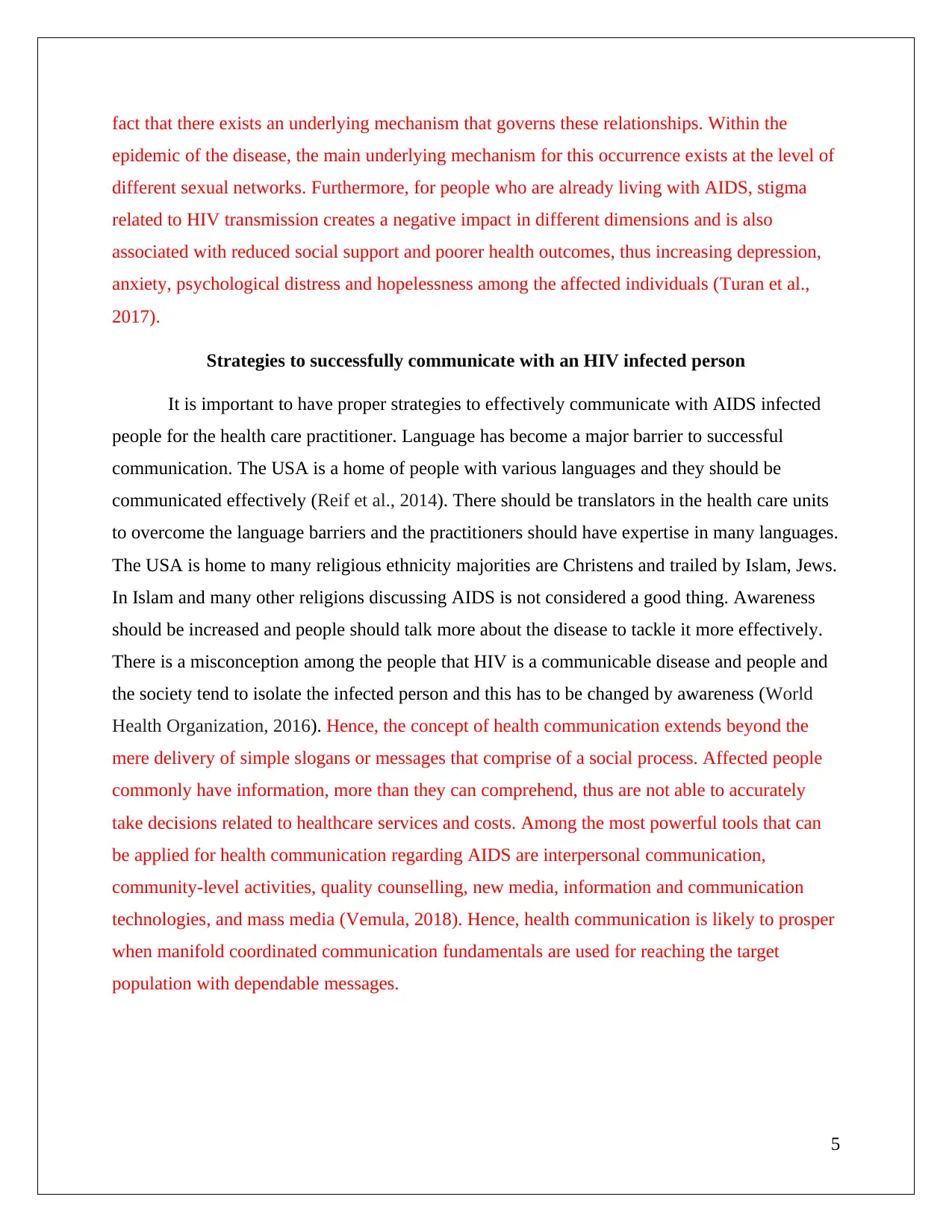
fact that there exists an underlying mechanism that governs these relationships. Within the
epidemic of the disease, the main underlying mechanism for this occurrence exists at the level of
different sexual networks. Furthermore, for people who are already living with AIDS, stigma
related to HIV transmission creates a negative impact in different dimensions and is also
associated with reduced social support and poorer health outcomes, thus increasing depression,
anxiety, psychological distress and hopelessness among the affected individuals (Turan et al.,
2017).
Strategies to successfully communicate with an HIV infected person
It is important to have proper strategies to effectively communicate with AIDS infected
people for the health care practitioner. Language has become a major barrier to successful
communication. The USA is a home of people with various languages and they should be
communicated effectively (Reif et al., 2014). There should be translators in the health care units
to overcome the language barriers and the practitioners should have expertise in many languages.
The USA is home to many religious ethnicity majorities are Christens and trailed by Islam, Jews.
In Islam and many other religions discussing AIDS is not considered a good thing. Awareness
should be increased and people should talk more about the disease to tackle it more effectively.
There is a misconception among the people that HIV is a communicable disease and people and
the society tend to isolate the infected person and this has to be changed by awareness (World
Health Organization, 2016). Hence, the concept of health communication extends beyond the
mere delivery of simple slogans or messages that comprise of a social process. Affected people
commonly have information, more than they can comprehend, thus are not able to accurately
take decisions related to healthcare services and costs. Among the most powerful tools that can
be applied for health communication regarding AIDS are interpersonal communication,
community-level activities, quality counselling, new media, information and communication
technologies, and mass media (Vemula, 2018). Hence, health communication is likely to prosper
when manifold coordinated communication fundamentals are used for reaching the target
population with dependable messages.
5
epidemic of the disease, the main underlying mechanism for this occurrence exists at the level of
different sexual networks. Furthermore, for people who are already living with AIDS, stigma
related to HIV transmission creates a negative impact in different dimensions and is also
associated with reduced social support and poorer health outcomes, thus increasing depression,
anxiety, psychological distress and hopelessness among the affected individuals (Turan et al.,
2017).
Strategies to successfully communicate with an HIV infected person
It is important to have proper strategies to effectively communicate with AIDS infected
people for the health care practitioner. Language has become a major barrier to successful
communication. The USA is a home of people with various languages and they should be
communicated effectively (Reif et al., 2014). There should be translators in the health care units
to overcome the language barriers and the practitioners should have expertise in many languages.
The USA is home to many religious ethnicity majorities are Christens and trailed by Islam, Jews.
In Islam and many other religions discussing AIDS is not considered a good thing. Awareness
should be increased and people should talk more about the disease to tackle it more effectively.
There is a misconception among the people that HIV is a communicable disease and people and
the society tend to isolate the infected person and this has to be changed by awareness (World
Health Organization, 2016). Hence, the concept of health communication extends beyond the
mere delivery of simple slogans or messages that comprise of a social process. Affected people
commonly have information, more than they can comprehend, thus are not able to accurately
take decisions related to healthcare services and costs. Among the most powerful tools that can
be applied for health communication regarding AIDS are interpersonal communication,
community-level activities, quality counselling, new media, information and communication
technologies, and mass media (Vemula, 2018). Hence, health communication is likely to prosper
when manifold coordinated communication fundamentals are used for reaching the target
population with dependable messages.
5
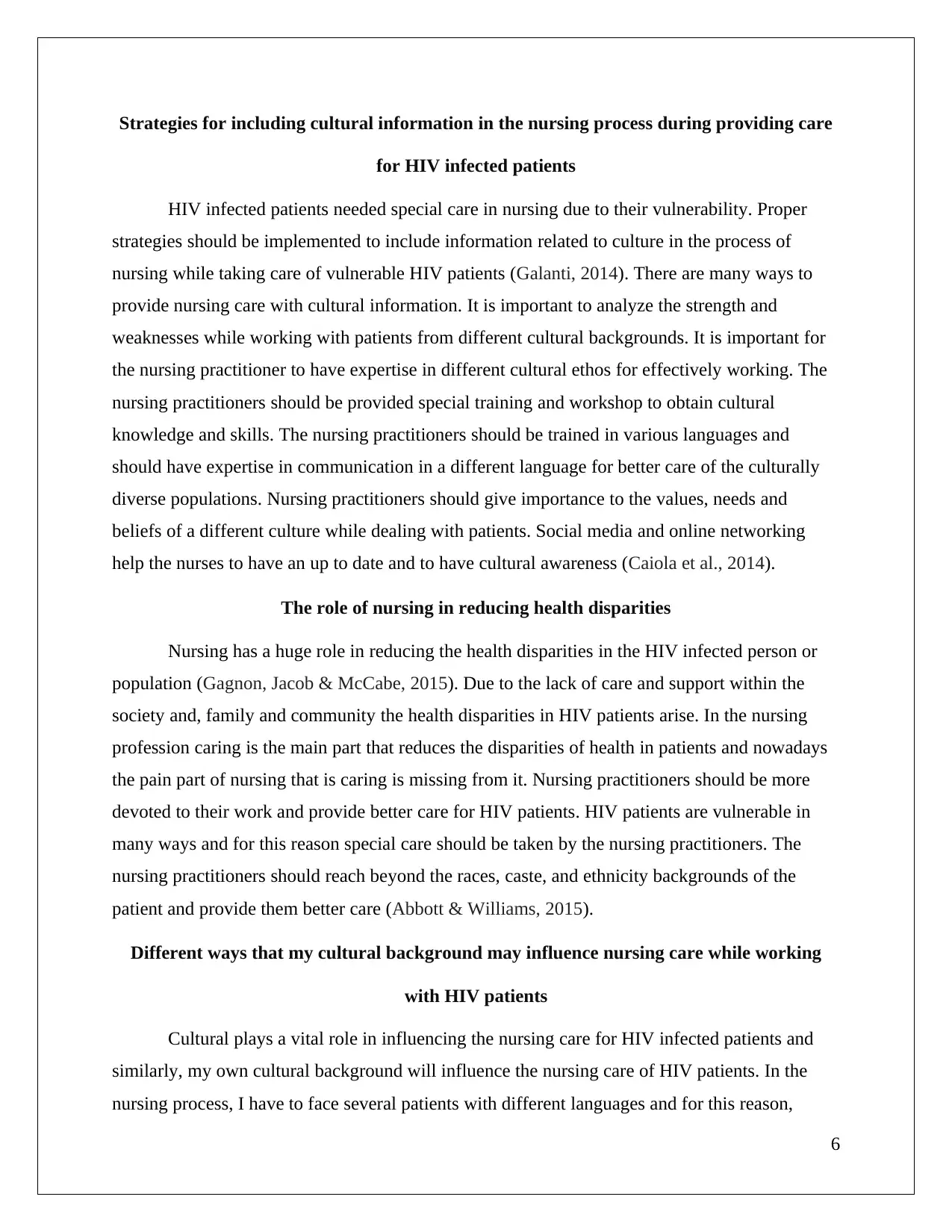
Strategies for including cultural information in the nursing process during providing care
for HIV infected patients
HIV infected patients needed special care in nursing due to their vulnerability. Proper
strategies should be implemented to include information related to culture in the process of
nursing while taking care of vulnerable HIV patients (Galanti, 2014). There are many ways to
provide nursing care with cultural information. It is important to analyze the strength and
weaknesses while working with patients from different cultural backgrounds. It is important for
the nursing practitioner to have expertise in different cultural ethos for effectively working. The
nursing practitioners should be provided special training and workshop to obtain cultural
knowledge and skills. The nursing practitioners should be trained in various languages and
should have expertise in communication in a different language for better care of the culturally
diverse populations. Nursing practitioners should give importance to the values, needs and
beliefs of a different culture while dealing with patients. Social media and online networking
help the nurses to have an up to date and to have cultural awareness (Caiola et al., 2014).
The role of nursing in reducing health disparities
Nursing has a huge role in reducing the health disparities in the HIV infected person or
population (Gagnon, Jacob & McCabe, 2015). Due to the lack of care and support within the
society and, family and community the health disparities in HIV patients arise. In the nursing
profession caring is the main part that reduces the disparities of health in patients and nowadays
the pain part of nursing that is caring is missing from it. Nursing practitioners should be more
devoted to their work and provide better care for HIV patients. HIV patients are vulnerable in
many ways and for this reason special care should be taken by the nursing practitioners. The
nursing practitioners should reach beyond the races, caste, and ethnicity backgrounds of the
patient and provide them better care (Abbott & Williams, 2015).
Different ways that my cultural background may influence nursing care while working
with HIV patients
Cultural plays a vital role in influencing the nursing care for HIV infected patients and
similarly, my own cultural background will influence the nursing care of HIV patients. In the
nursing process, I have to face several patients with different languages and for this reason,
6
for HIV infected patients
HIV infected patients needed special care in nursing due to their vulnerability. Proper
strategies should be implemented to include information related to culture in the process of
nursing while taking care of vulnerable HIV patients (Galanti, 2014). There are many ways to
provide nursing care with cultural information. It is important to analyze the strength and
weaknesses while working with patients from different cultural backgrounds. It is important for
the nursing practitioner to have expertise in different cultural ethos for effectively working. The
nursing practitioners should be provided special training and workshop to obtain cultural
knowledge and skills. The nursing practitioners should be trained in various languages and
should have expertise in communication in a different language for better care of the culturally
diverse populations. Nursing practitioners should give importance to the values, needs and
beliefs of a different culture while dealing with patients. Social media and online networking
help the nurses to have an up to date and to have cultural awareness (Caiola et al., 2014).
The role of nursing in reducing health disparities
Nursing has a huge role in reducing the health disparities in the HIV infected person or
population (Gagnon, Jacob & McCabe, 2015). Due to the lack of care and support within the
society and, family and community the health disparities in HIV patients arise. In the nursing
profession caring is the main part that reduces the disparities of health in patients and nowadays
the pain part of nursing that is caring is missing from it. Nursing practitioners should be more
devoted to their work and provide better care for HIV patients. HIV patients are vulnerable in
many ways and for this reason special care should be taken by the nursing practitioners. The
nursing practitioners should reach beyond the races, caste, and ethnicity backgrounds of the
patient and provide them better care (Abbott & Williams, 2015).
Different ways that my cultural background may influence nursing care while working
with HIV patients
Cultural plays a vital role in influencing the nursing care for HIV infected patients and
similarly, my own cultural background will influence the nursing care of HIV patients. In the
nursing process, I have to face several patients with different languages and for this reason,
6
⊘ This is a preview!⊘
Do you want full access?
Subscribe today to unlock all pages.

Trusted by 1+ million students worldwide
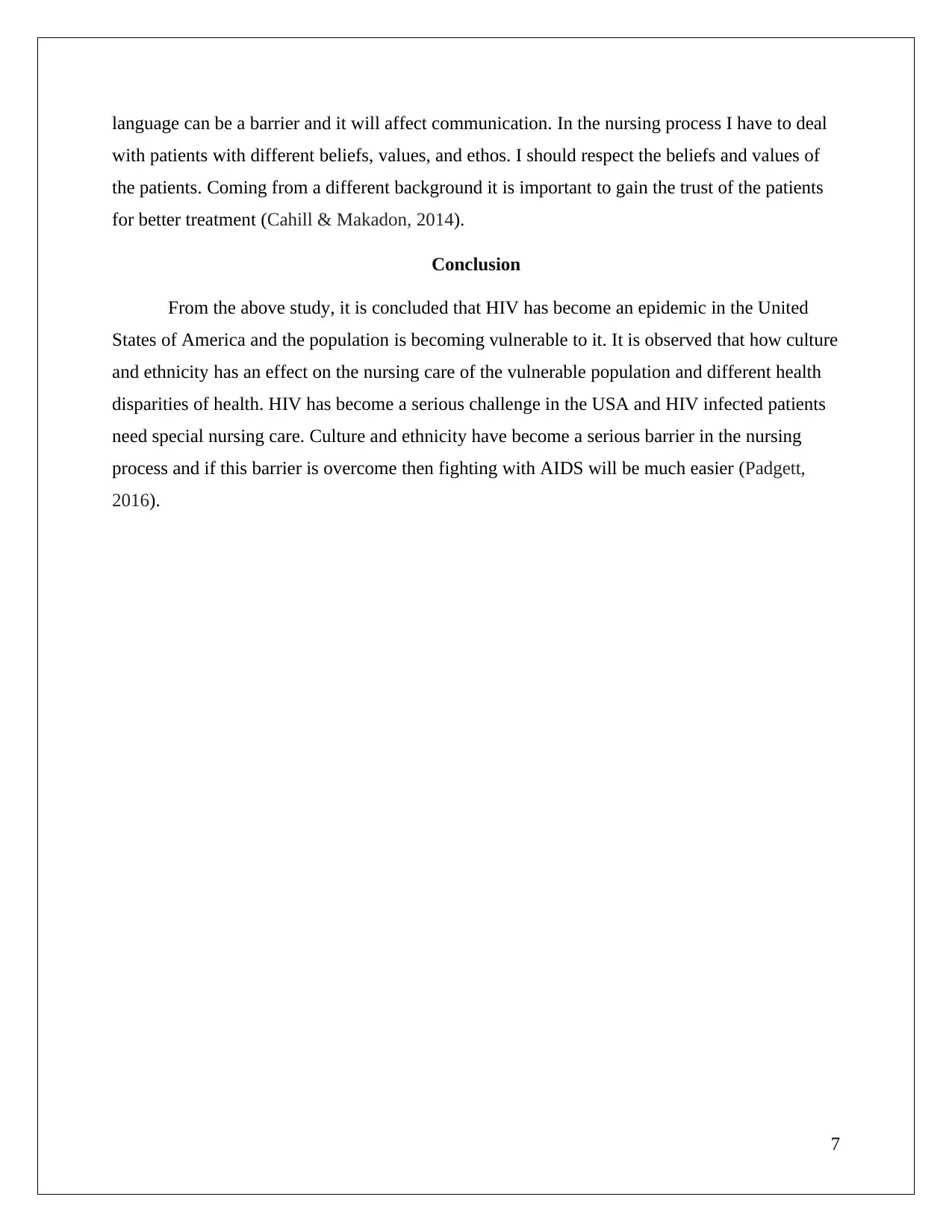
language can be a barrier and it will affect communication. In the nursing process I have to deal
with patients with different beliefs, values, and ethos. I should respect the beliefs and values of
the patients. Coming from a different background it is important to gain the trust of the patients
for better treatment (Cahill & Makadon, 2014).
Conclusion
From the above study, it is concluded that HIV has become an epidemic in the United
States of America and the population is becoming vulnerable to it. It is observed that how culture
and ethnicity has an effect on the nursing care of the vulnerable population and different health
disparities of health. HIV has become a serious challenge in the USA and HIV infected patients
need special nursing care. Culture and ethnicity have become a serious barrier in the nursing
process and if this barrier is overcome then fighting with AIDS will be much easier (Padgett,
2016).
7
with patients with different beliefs, values, and ethos. I should respect the beliefs and values of
the patients. Coming from a different background it is important to gain the trust of the patients
for better treatment (Cahill & Makadon, 2014).
Conclusion
From the above study, it is concluded that HIV has become an epidemic in the United
States of America and the population is becoming vulnerable to it. It is observed that how culture
and ethnicity has an effect on the nursing care of the vulnerable population and different health
disparities of health. HIV has become a serious challenge in the USA and HIV infected patients
need special nursing care. Culture and ethnicity have become a serious barrier in the nursing
process and if this barrier is overcome then fighting with AIDS will be much easier (Padgett,
2016).
7
Paraphrase This Document
Need a fresh take? Get an instant paraphrase of this document with our AI Paraphraser
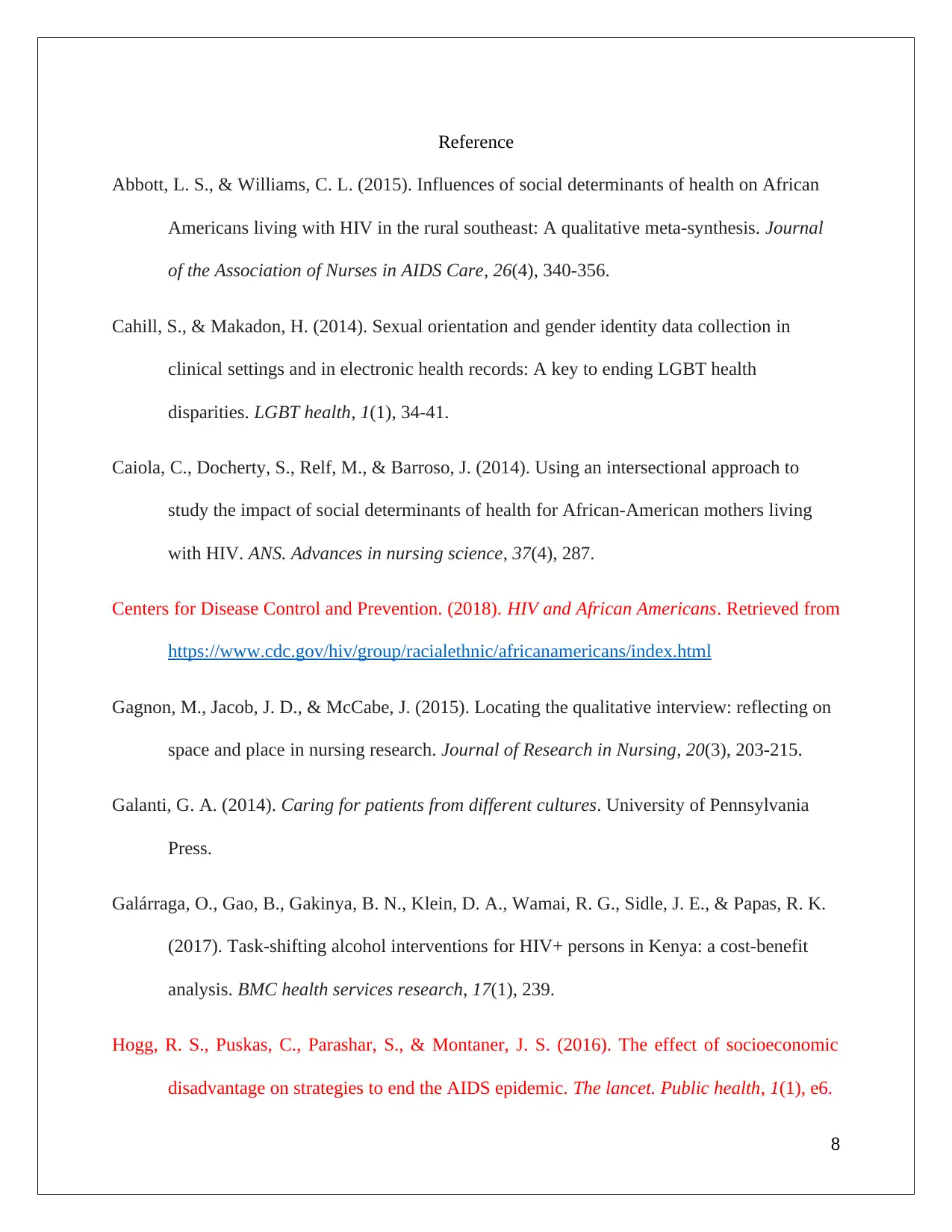
Reference
Abbott, L. S., & Williams, C. L. (2015). Influences of social determinants of health on African
Americans living with HIV in the rural southeast: A qualitative meta-synthesis. Journal
of the Association of Nurses in AIDS Care, 26(4), 340-356.
Cahill, S., & Makadon, H. (2014). Sexual orientation and gender identity data collection in
clinical settings and in electronic health records: A key to ending LGBT health
disparities. LGBT health, 1(1), 34-41.
Caiola, C., Docherty, S., Relf, M., & Barroso, J. (2014). Using an intersectional approach to
study the impact of social determinants of health for African-American mothers living
with HIV. ANS. Advances in nursing science, 37(4), 287.
Centers for Disease Control and Prevention. (2018). HIV and African Americans. Retrieved from
https://www.cdc.gov/hiv/group/racialethnic/africanamericans/index.html
Gagnon, M., Jacob, J. D., & McCabe, J. (2015). Locating the qualitative interview: reflecting on
space and place in nursing research. Journal of Research in Nursing, 20(3), 203-215.
Galanti, G. A. (2014). Caring for patients from different cultures. University of Pennsylvania
Press.
Galárraga, O., Gao, B., Gakinya, B. N., Klein, D. A., Wamai, R. G., Sidle, J. E., & Papas, R. K.
(2017). Task-shifting alcohol interventions for HIV+ persons in Kenya: a cost-benefit
analysis. BMC health services research, 17(1), 239.
Hogg, R. S., Puskas, C., Parashar, S., & Montaner, J. S. (2016). The effect of socioeconomic
disadvantage on strategies to end the AIDS epidemic. The lancet. Public health, 1(1), e6.
8
Abbott, L. S., & Williams, C. L. (2015). Influences of social determinants of health on African
Americans living with HIV in the rural southeast: A qualitative meta-synthesis. Journal
of the Association of Nurses in AIDS Care, 26(4), 340-356.
Cahill, S., & Makadon, H. (2014). Sexual orientation and gender identity data collection in
clinical settings and in electronic health records: A key to ending LGBT health
disparities. LGBT health, 1(1), 34-41.
Caiola, C., Docherty, S., Relf, M., & Barroso, J. (2014). Using an intersectional approach to
study the impact of social determinants of health for African-American mothers living
with HIV. ANS. Advances in nursing science, 37(4), 287.
Centers for Disease Control and Prevention. (2018). HIV and African Americans. Retrieved from
https://www.cdc.gov/hiv/group/racialethnic/africanamericans/index.html
Gagnon, M., Jacob, J. D., & McCabe, J. (2015). Locating the qualitative interview: reflecting on
space and place in nursing research. Journal of Research in Nursing, 20(3), 203-215.
Galanti, G. A. (2014). Caring for patients from different cultures. University of Pennsylvania
Press.
Galárraga, O., Gao, B., Gakinya, B. N., Klein, D. A., Wamai, R. G., Sidle, J. E., & Papas, R. K.
(2017). Task-shifting alcohol interventions for HIV+ persons in Kenya: a cost-benefit
analysis. BMC health services research, 17(1), 239.
Hogg, R. S., Puskas, C., Parashar, S., & Montaner, J. S. (2016). The effect of socioeconomic
disadvantage on strategies to end the AIDS epidemic. The lancet. Public health, 1(1), e6.
8
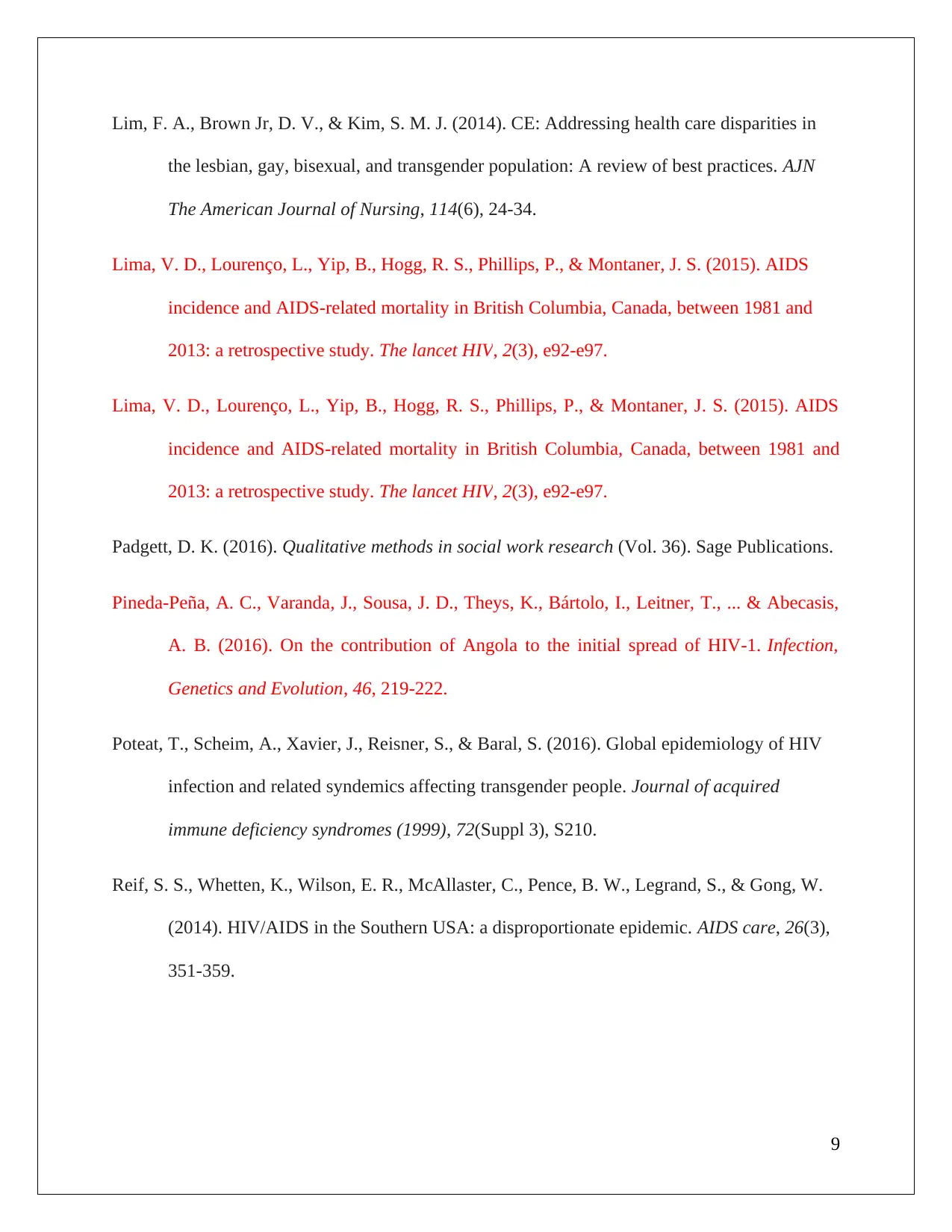
Lim, F. A., Brown Jr, D. V., & Kim, S. M. J. (2014). CE: Addressing health care disparities in
the lesbian, gay, bisexual, and transgender population: A review of best practices. AJN
The American Journal of Nursing, 114(6), 24-34.
Lima, V. D., Lourenço, L., Yip, B., Hogg, R. S., Phillips, P., & Montaner, J. S. (2015). AIDS
incidence and AIDS-related mortality in British Columbia, Canada, between 1981 and
2013: a retrospective study. The lancet HIV, 2(3), e92-e97.
Lima, V. D., Lourenço, L., Yip, B., Hogg, R. S., Phillips, P., & Montaner, J. S. (2015). AIDS
incidence and AIDS-related mortality in British Columbia, Canada, between 1981 and
2013: a retrospective study. The lancet HIV, 2(3), e92-e97.
Padgett, D. K. (2016). Qualitative methods in social work research (Vol. 36). Sage Publications.
Pineda-Peña, A. C., Varanda, J., Sousa, J. D., Theys, K., Bártolo, I., Leitner, T., ... & Abecasis,
A. B. (2016). On the contribution of Angola to the initial spread of HIV-1. Infection,
Genetics and Evolution, 46, 219-222.
Poteat, T., Scheim, A., Xavier, J., Reisner, S., & Baral, S. (2016). Global epidemiology of HIV
infection and related syndemics affecting transgender people. Journal of acquired
immune deficiency syndromes (1999), 72(Suppl 3), S210.
Reif, S. S., Whetten, K., Wilson, E. R., McAllaster, C., Pence, B. W., Legrand, S., & Gong, W.
(2014). HIV/AIDS in the Southern USA: a disproportionate epidemic. AIDS care, 26(3),
351-359.
9
the lesbian, gay, bisexual, and transgender population: A review of best practices. AJN
The American Journal of Nursing, 114(6), 24-34.
Lima, V. D., Lourenço, L., Yip, B., Hogg, R. S., Phillips, P., & Montaner, J. S. (2015). AIDS
incidence and AIDS-related mortality in British Columbia, Canada, between 1981 and
2013: a retrospective study. The lancet HIV, 2(3), e92-e97.
Lima, V. D., Lourenço, L., Yip, B., Hogg, R. S., Phillips, P., & Montaner, J. S. (2015). AIDS
incidence and AIDS-related mortality in British Columbia, Canada, between 1981 and
2013: a retrospective study. The lancet HIV, 2(3), e92-e97.
Padgett, D. K. (2016). Qualitative methods in social work research (Vol. 36). Sage Publications.
Pineda-Peña, A. C., Varanda, J., Sousa, J. D., Theys, K., Bártolo, I., Leitner, T., ... & Abecasis,
A. B. (2016). On the contribution of Angola to the initial spread of HIV-1. Infection,
Genetics and Evolution, 46, 219-222.
Poteat, T., Scheim, A., Xavier, J., Reisner, S., & Baral, S. (2016). Global epidemiology of HIV
infection and related syndemics affecting transgender people. Journal of acquired
immune deficiency syndromes (1999), 72(Suppl 3), S210.
Reif, S. S., Whetten, K., Wilson, E. R., McAllaster, C., Pence, B. W., Legrand, S., & Gong, W.
(2014). HIV/AIDS in the Southern USA: a disproportionate epidemic. AIDS care, 26(3),
351-359.
9
⊘ This is a preview!⊘
Do you want full access?
Subscribe today to unlock all pages.

Trusted by 1+ million students worldwide
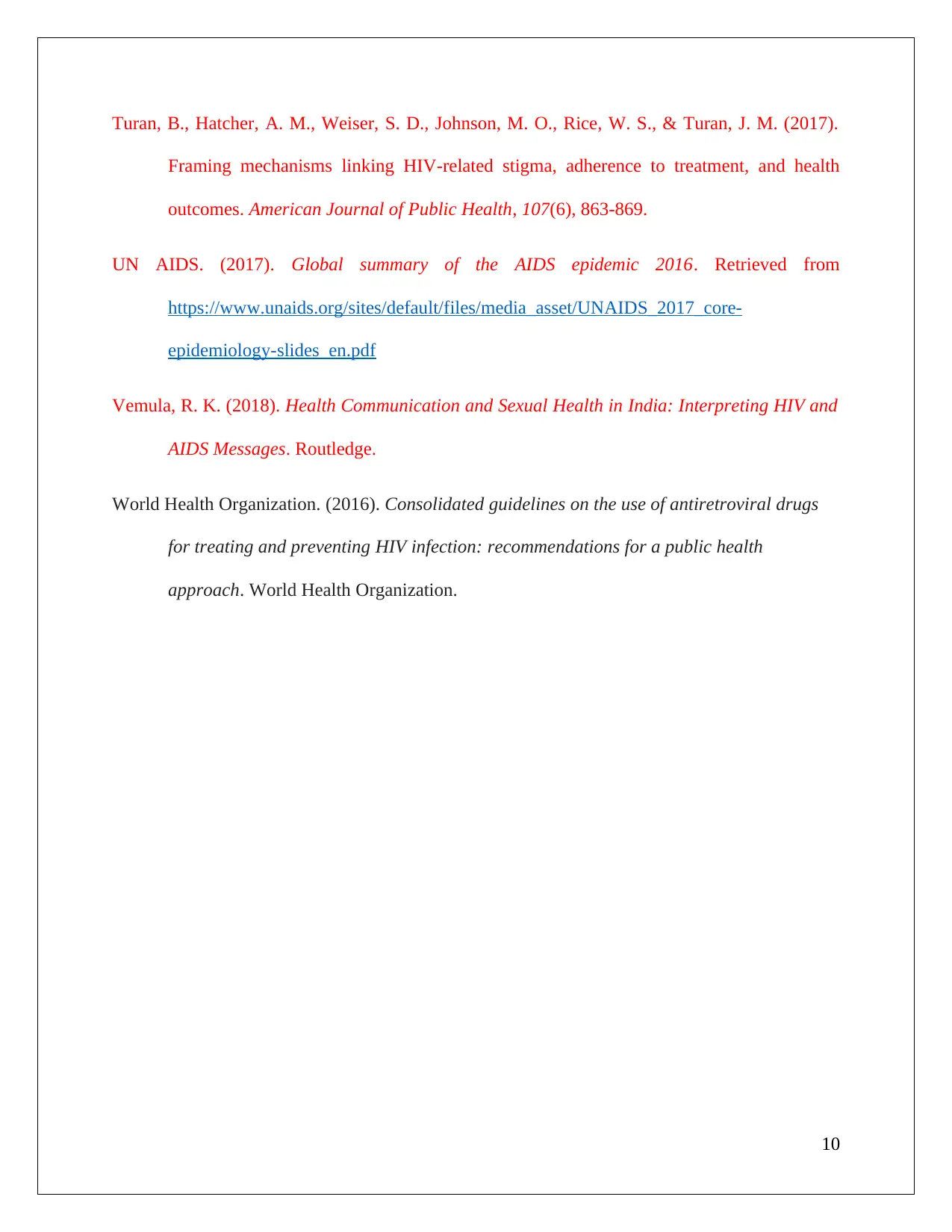
Turan, B., Hatcher, A. M., Weiser, S. D., Johnson, M. O., Rice, W. S., & Turan, J. M. (2017).
Framing mechanisms linking HIV-related stigma, adherence to treatment, and health
outcomes. American Journal of Public Health, 107(6), 863-869.
UN AIDS. (2017). Global summary of the AIDS epidemic 2016. Retrieved from
https://www.unaids.org/sites/default/files/media_asset/UNAIDS_2017_core-
epidemiology-slides_en.pdf
Vemula, R. K. (2018). Health Communication and Sexual Health in India: Interpreting HIV and
AIDS Messages. Routledge.
World Health Organization. (2016). Consolidated guidelines on the use of antiretroviral drugs
for treating and preventing HIV infection: recommendations for a public health
approach. World Health Organization.
10
Framing mechanisms linking HIV-related stigma, adherence to treatment, and health
outcomes. American Journal of Public Health, 107(6), 863-869.
UN AIDS. (2017). Global summary of the AIDS epidemic 2016. Retrieved from
https://www.unaids.org/sites/default/files/media_asset/UNAIDS_2017_core-
epidemiology-slides_en.pdf
Vemula, R. K. (2018). Health Communication and Sexual Health in India: Interpreting HIV and
AIDS Messages. Routledge.
World Health Organization. (2016). Consolidated guidelines on the use of antiretroviral drugs
for treating and preventing HIV infection: recommendations for a public health
approach. World Health Organization.
10
1 out of 10
Related Documents
Your All-in-One AI-Powered Toolkit for Academic Success.
+13062052269
info@desklib.com
Available 24*7 on WhatsApp / Email
![[object Object]](/_next/static/media/star-bottom.7253800d.svg)
Unlock your academic potential
Copyright © 2020–2025 A2Z Services. All Rights Reserved. Developed and managed by ZUCOL.





